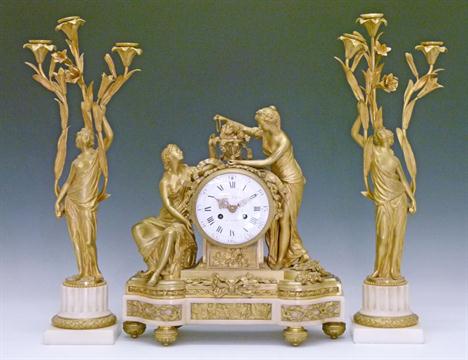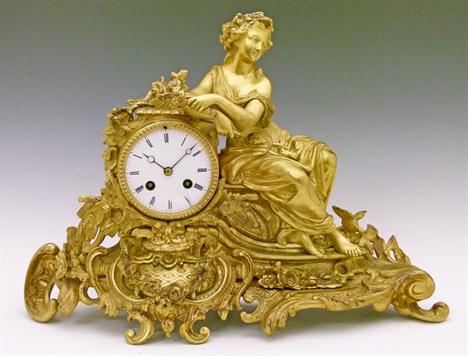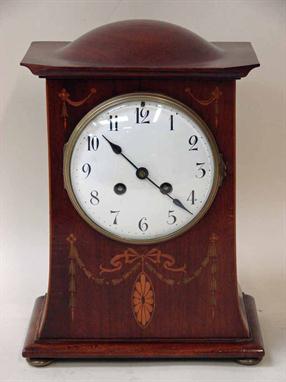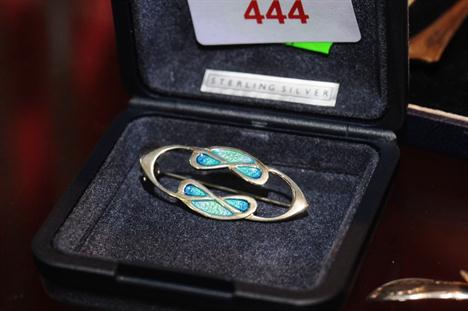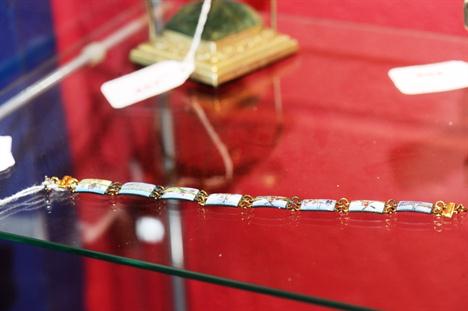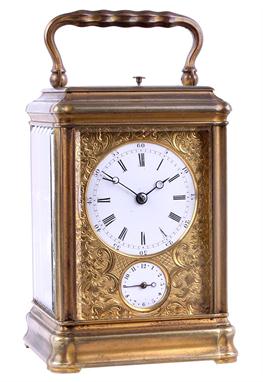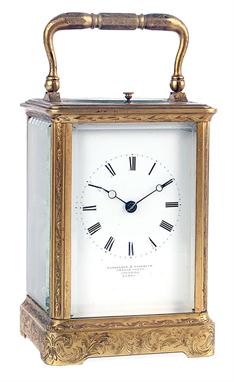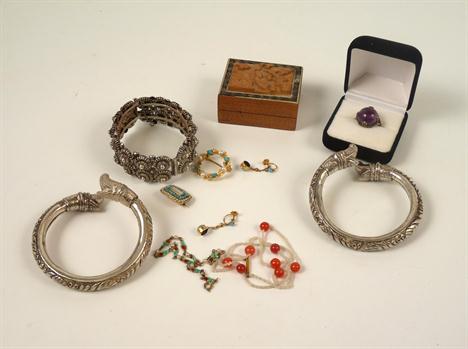Louis XVI style ormolu and white marble garniture de cheminee, the clock having a circular white enamel dial signed Hartingue A Paris, the chapter ring with Roman and Arabic numerals, figural case with two classical maidens and bearing foundry mark of Eugene Bazart and standing on a white marble base, the brass movement striking on a bell and with trade mark bearing the initials JLF and EMS, 42.5cm high, the three branch candelabra each formed as a classical maiden and standing on a conforming white marble base, 59cm high
396325 Preisdatenbank Los(e) gefunden, die Ihrer Suche entsprechen
396325 Lose gefunden, die zu Ihrer Suche passen. Abonnieren Sie die Preisdatenbank, um sofortigen Zugriff auf alle Dienstleistungen der Preisdatenbank zu haben.
Preisdatenbank abonnieren- Liste
- Galerie
-
396325 Los(e)/Seite
19th Century brass mounted ebonised cased timepiece by Barraud of London, the watch movement signed Barraud, Cornhill, London and numbered 6033, white enamel dial also signed and numbered and mounted within an engraved foliate plate, the case with carrying handle and standing on pressed brass feet, height with handle raised 16.5cm
French gilt brass gorge cased Grande Sonnerie carriage clock, possibly by Drocourt of Paris, white enamel dial with Roman and Arabic numerals and subsidiary alarm dial, strike selection lever to the underside, dial with retailers mark for T. Martin & Co, 151, Regent St, London, stamped number to base, 28539, height with handle raised 17cm
19th Century Meissen clock case, having figural decoration depicting a lady in classical robes, a dog at her side and a putto seated atop the architecturally styled clock, base with blue crossed swords with single cancellation line, white enamel dial with Roman numerals and brass movement, 39.25cm high
A French Louis XIV gilt brass verge `oignon` pocket watch. Rouviere, Paris, early 18th century, The gilt full plate chain fusee movement winding through the dial centre cannon pinion, with Egyptian pillars, silvered regulation disc geared to rack regulator, plain steel three-arm balance beneath ho-ho bird and foliate scroll pierced balance bridge and signed ROUVIERE APARIS to backplate, the twelve piece blue on white enamel Roman numeral cartouche dial with inner enamel quarter hour track and foliate scroll chased centre, the two piece hinged case further chased with intertwined arabesque designs within repeating strapwork panels to rear cover, (lacking hands, case with wear) 5.5cm diameter.
A fine George I verge pocket watch movement and dial. John Bowen and John Masters, Bristol circa 1720. The full plate gilt movement with tulip pillars incorporating scroll-pieced galleries, silvered Tompion type regulator for the flat three-arm steel balance beneath pierced and engraved silver balance cock decorated with Ho-Ho birds and foliate scrolls above a female mask to the backplate signed Io/n BOWEN, Io/n MASTERS, BRISTOL, the white enamel Roman numeral dial with Arabic five minutes to outer track (hands and case lacking) the dial plate 4.5cm diameter. John Bowen and John Masters are recorded in Moore, A.J. THE CLOCKMAKERS OF BRISTOL 1650-1900 as working 1718-34 and 1699-1739 respectively.
An Edwardian silver cased miniature carriage timepiece. Edwards and Sons, London, 1905. The French eight-day movement with platform lever escapement and 1.25 inch circular white enamel Roman numeral dial signed EDWARDS & SONS, 161 REGENT St. LONDON W. to centre and with blued steel spade hands, the rectangular case with `C` scroll hinged handle, full-height rear door and bun feet, marked for makers JRH London 1905, 6.5cm (2.5ins) high excluding handle.
An Edwardian silver gilt mounted tortoiseshell miniature carriage timepiece. Unsigned, London, 1910. The French eight-day movement with platform lever escapement and 1.5 inch circular white enamel Roman numeral dial with blued steel spade hands set behind a glazed silver gilt bezel, the rectangular case with hinged silver gilt handle, hinge for the full-height rear door and on bun feet, the mounts marked HA&C London 1910, 9cm (3.5ins) high excluding handle.
An Edwardian silver cased miniature carriage timepiece. Unsigned, London, 1909. The French eight-day movement with platform cylinder escapement and 1.5 inch circular white enamel Roman numeral dial with blued steel spade hands, the rectangular case with hammered finish, `C` scroll hinged handle, full-height rear door and bun feet, marked for case makers H. Matthews, London 1909, 7.5cm (3ins) high excluding handle.
A French gilt brass gorge cased carriage clock with push-button repeat and alarm. Drocourt, Paris, Late 19th century, The eight-day two train gong striking movement with original silvered platform lever escapement with DC trademark for Drocourt and numbered 8749 to backplate, the circular white enamel Roman numeral dial with Arabic five minutes and blued steel Breguet hands set into a foliate engraved rectangular gilt brass mask incorporating subsidiary alarm setting dial to lower margin, the bevel glazed case with hinged carrying handle and repeat serial numbers to base, 13cm (5ins) high excluding handle, with original leather covered outer travelling case.
A fine French engraved gilt brass gorge cased alarm carriage clock with calendar and push-button repeat. Retailed by Grohe, London, late 19th century, The two train gong striking movement with silvered platform lever escapement and signed Grohe, London to backplate, the circular white enamel Roman numeral dial further signed GROHE, 7 WIGMORE STREET, LONDON to centre, with blued steel Breguet hands and set into a foliate engraved rectangular gilt brass mask with subsidiary date of the month and alarm setting dials to lower margin, the `gorge` case overall engraved with panels of scrolling foliate decoration a matted ground, the rear door with conforming scroll decorated brass panel incorporating shuttered winding holes, 13cm (5ins) high excluding handle, on original gilt brass base with conforming engraved decoration between mermaid engraved supports to angles, 17.5cm (7ins) high overall.
A French gilt brass petit sonnerie striking carriage clock with push-button repeat. Margaine, Paris, circa 1900. The two train eight-day movement with silvered platform lever escapement and striking the hours and quarters on two gongs, the backplate stamped with the beehive trademark for Margaine and inscribed J.C. & Co. FIRST QUALITY EXTRA, the rectangular white enamel Roman numeral dial with blued steel Breguet hands in a gilt `corniche` type case with hinged carrying handle, 15cm (6ins) high excluding handle.
A French gilt brass carriage clock in a one-piece case. Japy Freres, the case by L. Lange, Paris, mid 19th century, The eight-day two train bell striking movement with platform cylinder escapement and JAPY FRERES ANNEES MEDAILLES D`OR.. punch stamped trademark beneath number 58 to backplate, the rectangular white enamel Roman numeral enamel dial with blued steel Breguet hands, the gilt caddy moulded case of squat proportions with hinged carrying handle thick bevel cut glasses and gilt back door with shuttered winding holes on moulded skirt base stamped L.LANGE, 1296 to underside, 12cm (4.75ins) high excluding handle. One-piece cases by L. Lange are discussed in Allix, Charles and Bonnert, Peter CARRIAGE CLOCKS Their history and development pages 145 and 158 where it is noted that such cases were often used to house movements by Japy Freres.
A French cast gilt brass carriage clock with push-button repeat. Retailed by Henry & Co., Paris, mid 19th century, The eight day bell striking movement with unusual platform lever escapement and stamped with JAPY FRERES medallion and numbered 109 to backplate, the rectangular white enamel Roman numeral dial inscribed HENRY & Co., PARIS beneath chapter ring and with trefoil pierced blued steel hands, the bevel glazed gilt brass case with double cherub term cast hinged handle and foliate decorated mouldings above canted angles applied with standing figures in Renaissance style dress to recessed niches, on conforming cavetto base cast with repeating scrolls and with shaped apron, 15.5cm (6ins high) excluding handle. The balance pivot bridge arrangement to the escapement of the current lot is similar to one attributed to Jules of Paris illustrated in Allix, Charles and Bonnert, Peter CARRIAGE CLOCKS Their history and development plate II/47 page 224.
A French brass carriage clock with duplex escapement. Unsigned, mid 19th century, The eight-day two train bell striking movement with platform duplex escapement and rectangular white enamel Roman numeral dial in an early gilt brass multi-piece `corniche` bevel glazed case with hinged baton carrying handle above gilt back panel fitted with shuttered winding holes, on moulded skirt base, 13cm (5ins) high. A similar platform duplex escapement fitted to a clock by Lepine is illustrated in Allix, Charles and Bonnert, Peter CARRIAGE CLOCKS Their history and development plate II/42 page 71.
A French engraved gilt brass carriage clock with push-button repeat. Retailed by Parkinson and Frodsham, late 19th century, The eight-day two train gong striking movement with silvered platform lever escapement and rectangular white enamel Roman numeral dial inscribed PARKINSON & FRODSHAM, CHANGE ALLEY, CORNHILL, LONDON beneath chapter ring and with blued steel Breguet hands, the gilt `corniche` type case with foliate scroll engraved decoration throughout, 12.5cm (5ins) high excluding handle.
A Swiss nickel finished brass and spherical glass desk timepiece. Ancre, early 20th century, The keyless lever eight-day pocket watch movement with backplate applied with die-stamped gilt brass trade plate incorporating several exhibition award medallions and signed ANCRE, the circular white enamel Roman numeral dial inscribed 8 DAYS, SWISS MADE to centre, the nickel finish case with hemispherical solid glass covers front and back and suspension ring incorporating keyless winding, (with faults), diameter 7.5cm (3ins).
An ebonised sedan timepiece. Incorporating a watch movement by John Pepys, London circa 1700 the dial and case late 18th century, The gilt full-plate fusee verge pocket watch movement with pierced square section baluster pillars, elaborate foliate pierced backcock for the plain three-arm balance, silvered regulation dial and signed John Pepys, London to backplate, the 3.25 inch convex Roman numeral enamel dial with Arabic quarters to outer track and chased gilt beetle and poker hands within glazed cast brass bezel and turned cavetto moulded surround, the rear with hinged brass cover, 13cm (5ins) diameter. John Pepys is recorded in Loomes, Brian The Early CLOCKMAKERS of Great Britain as born circa 1658, he was apprenticed to John Harris and gained his freedom of the Clockmakers` Company in 1680. He was made an Assistant of the Clockmakers` Company in 1697, Warden from 1705, Master in 1707 and is thought to have died around 1720.
A Black Forest miniature weight driven wall clock with alarm. Unsigned, late 19th century, The two train wooden framed outside countwheel bell striking movement with anchor escapement and transverse alarm mounted to the right hand side of the movement, the 2.25 inch circular white enamel Roman numeral dial with brass alarm setting disc to centre and with lakeland landscape painted scene to arched panel above, complete with side doors, hanging hoop and spurs, pendulum and weights, 10cm (4ins) high.
An engraved brass mounted ebonised small mantel clock now incorporating a musical box mechanism. Unsigned, probably Austrian, mid 19th century and later. The two train bell striking movement with push-button hour repeat, standing barrels, anchor escapement and shaped plates, the white enamel Roman numeral waisted dial with elaborate scroll hands and overlaid with a pierced and engraved brass decoration to the lower section, in a waisted ebonised case with button finial and ogee moulded surmount above rectangular side windows, the front and side surfaces overlaid with conforming shaped pierced and engraved lacquered brass decoration, on two later gilt brass rail supports, 24cm (9.5ins) high; with original conforming ebonised plinth applied with further decorative brass mounts and now fitted to upper surface with a later musical box mechanism formerly playing a choice of two airs via a 2.25 inch cylinder and tuned steel comb within brass frame and glazed cover, on scroll cast brass feet, (musical mechanism incomplete, dial with faults) 18.5cm (11.25ins) high overall.
A French gilt brass four glass mantel clock. Retailed by Aird and Thomson, late 19th century, The eight-day two train bell striking movement with twin mercury jar pendulum and visible Brocot escapement to the recessed centre of the two-piece white enamel Roman numeral dial with blued steel Breguet hands and signed AIRD & THOMSON between the winding squares, the heavy brass bevel-glazed case with channel cut corners to the moulded cornice and rounded uprights above cavetto moulded skirt base with conforming detail to angles and incorporating bracket feet, 36cm (14ins) high.
An oak and red serpentine descending rack gravity timepiece. Attributed to M.E. Gravity Clock, London, circa 1900. The single train French made movement with platform lever escapement powered by its own weight moving down a vertical toothed rack, the circular white enamel Roman numeral dial with red Arabic quarters within the outer minute track and with fixed brass glazed bezel, set into a red serpentine stone mounted ovoid case mounted onto a vertical toothed upright within break-arch pedimented case with four slender column uprights and on rectangular cavetto moulded platform base, 37cm (14.5ins) high.
A French Louis Philippe ormolu mantel clock. J.B. Beguin, Paris, mid 19th century, The eight-day outside countwheel bell striking movement with circular white enamel Roman numeral dial signed J.B. Beguin, A PARIS to centre and within cartouche shaped cast bezel, the elaborate case cast in the 16th century revival style with surmount of an angel surrounded by objects emblematic of the arts over double concave panel frieze relief decorated with masks and rosettes, the front with martial trophy beneath dial flanked by spiral twist Corinthian columns and concave side sections applied with niches supporting figures in 16th century dress, on conforming strapwork panel cast shaped swept base with pierced scroll feet to angles and winged dragon to apron between, 47cm (18.5ins) high.
A French Louis XVI style ormolu mounted marble mantel clock. Unsigned, Paris, 19th century, The eight-day outside countwheel bell striking movement with circular white enamel convex Arabic numeral dial inscribed a Paris to centre and with pierced and engraved gilt brass hands within an engine turned glazed bezel, the case with chased gilt surmount modelled as a cherub with a flaming torch supported on a billowing cloud above moulded white marble cornice and side scrolls flanking a black marble rectangular central section applied with cast stylised foliate scroll mounts around dial, on black marble banded plinth base applied with conforming foliate mounts to lower edge and on engine turned gilt feet, 34cm (13.5ins) high.
A French Empire ormolu figural mantel clock. Choiselat-Gallien, Paris, early 19th century, The outside countwheel striking movement with silk suspension and circular white enamel Roman numeral dial signed CHOISELAT-GALLIEN, Fab`t de Bronzes du Garde-Meuble, LESIEUR Hs, A PARIS to centre within gilt lotus leaf cast bezel and set into a rectangular plinth with scroll cast decoration above and below and surmounted with an oil lamp and two books applied beside classical male scholar seated on an X-frame stool onto a rectangular base applied with central urn and wreath flanked by flaming torches to front and on engine turned bun feet (lacking pendulum, bell and minute hand), 38cm (15ins) high.
A French Sevres style porcelain inset ormolu mantel clock. Unsigned, circa 1870. The eight-day bell striking movement with circular white enamel Roman numeral dial with Breguet hands within repeating leaf cast bezel, the case with ovoid surmount painted with gilt bordered vignettes of exotic birds above egg-and-dart cornice and front with leaf cast fan shaped mounts to upper quadrants and shaped cherub decorated panel beneath dial, the sides with curved panels further decorated with exotic birds, on acanthus cast and chased moulded plinth base with foliate trails to skirt and turned feet, 35.5cm (14ins) high.
A French ormolu mounted white and grey marble mantel clock. Antoine Martin, Paris, circa 1800. The eight-day outside countwheel bell striking movement with silk suspension and circular white enamel convex Arabic numeral dial inscribed A.the Martin, a Paris in puce to centre, with gilt brass hands and within hinged gilt bead-cast glazed bezel, the case with surmount modelled as a vase of flowers above leafy side scrolls and festoon husk cast swag beneath dial, raised on rectangular section uprights applied with leafy mounts flanked by further slender inverted baluster uprights and with sunburst mask pendulum swinging between, on lozenge-outline platform base inset with further leafy mounts to borders and with cast feet, 42cm (16.5ins) high. An Antoine Thomas Martin is recorded in Baillie, G.H. Watchmakers & Clockmakers of the World as working in Paris circa 1788.
A French patinated bronze mantel clock garniture. Desnoue, Nantes, circa 1870. The eight-day bell striking movement with twelve-piece blue on white enamel Roman numeral dial signed DESNOUE FAB`T, NANTES to an enamel plaque to the upper border of the rosette cast centre, within egg-and-dart cast surround and bevel glazed bezel, the case with urn surmount above festoon husk draped decoration beneath dial issuing from the stylised lion`s mask cast masks with pendant handles to sides, the pedestal base fronted with a foliate scroll inset shaped cartouche flanked by openwork decoration and waisted block feet, 50cm (19.75ins) high; with a pair of conforming six-light candelabra, each with central nozzle above five scroll shaped branches and foliate cast upright applied with lion`s mask handles to the central knop, on conforming base with openwork side scrolls and fronted with a shaped panel flanked by waisted block feet, each 54cm (21.25ins) high (3).
A French Louis Philippe engraved gilt brass mounted tortoiseshell small portico mantel clock. Leroy, Paris, mid 19th century, The eight-day outside countwheel bell striking movement stamped LEROY A PARIS to backplate, the circular white enamel Roman numeral dial similarly signed to centre and with pierced blued steel hands within moulded gilt bezel, the mottled red shell veneered case with ogee shaped pediment fronted with scroll pierced and engraved gilt brass mounts around the dial, on four Corinthian column uprights with rosette cast `gridiron` pendulum swinging between, the inverted breakfronted plinth base with conforming shaped gilt mounts to upper surface and front panels and with ogee moulded skirt, 30cm (11.75ins) high; with an ogee moulded plinth base with canted angles, 35.5cm (14ins) high overall.
A French Louis XV style gilt brass small mantel clock Retailed by Whistler, London, mid 19th century The eight-day bell striking movement with blue on white enamel Roman numeral dial in a waisted rococo scroll cast case with foliate knop finial above shaped cast brass grille side frets and conforming panel to apron, on scroll feet and mounted on a conforming scroll cast shaped platform base with pierced feet, the rear of the case engraved Whistler, 11 Strand, 34.5cm (13.5ins) high.
A French Louis XVI style gilt brass mounted white marble small mantel clock. Unsigned, circa 1900. The outside countwheel bell striking movement with floral garland decorated white Arabic numeral enamel dial with cast brass hands within engine turned glazed bezel, the arched case with twin handled urn surmount and ribbon tied cast crest above acanthus side scrolls and tied flaming torch beneath dial, on inverted breakfront base with bowed central section fronted with intertwined laurel cast mount, on engine turned feet, 28cm (11ins) high.
A metalwares silver engine turned rectangular cigarette case, the cover decorated with a lady in 18th century costume in black enamel, 8cm long by 5.5cm wide, and a silver gilt engine turned square shape cigarette case, London 1913, with applied rose gold monogram `P de B` for Patrick de Bathe, 7.5cm square (2)
-
396325 Los(e)/Seite
